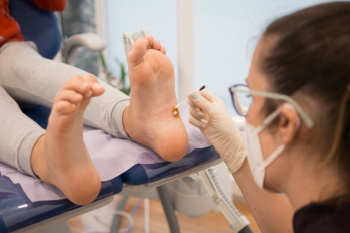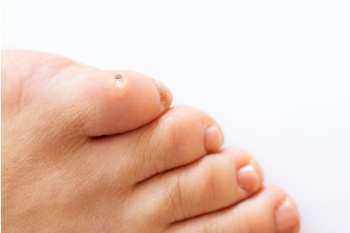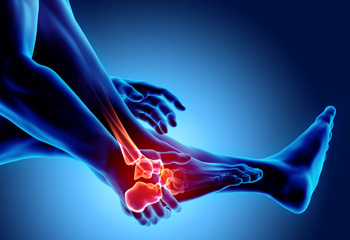February 2024
Causes and Characteristics of Plantar Warts

Plantar warts, though benign, are contagious and can be a source of discomfort for many individuals. These small, grainy growths typically develop on the soles of the feet, particularly in areas that bear weight such as the heel or ball of the feet. Plantar warts are caused by the human papillomavirus, or HPV, specifically strains that thrive in warm, moist environments. Plantar warts often enter the body through tiny cuts or breaks in the skin. Walking barefoot in public places like locker rooms, swimming pools, or communal showers can increase the risk of exposure to the virus. Additionally, individuals with weakened immune systems or compromised skin integrity are more susceptible to developing plantar warts. The pressure and friction exerted on the feet during walking can flatten plantar warts, causing them to grow inward and become painful. While plantar warts may resolve on their own over time, seeking treatment from a podiatrist can help alleviate discomfort and prevent them from spreading to other areas of the feet or to other individuals. If you have developed a plantar wart, it is suggested that you visit a podiatrist who can offer effective treatment solutions.
Plantar warts can be very uncomfortable. If you need your feet checked, contact Joseph D. Ruffo, DPM, PC from New York. Our doctor will assist you with all of your foot and ankle needs.
About Plantar Warts
Plantar warts are the result of HPV, or human papillomavirus, getting into open wounds on the feet. They are mostly found on the heels or balls of the feet.
While plantar warts are generally harmless, those experiencing excessive pain or those suffering from diabetes or a compromised immune system require immediate medical care. Plantar warts are easily diagnosed, usually through scraping off a bit of rough skin or by getting a biopsy.
Symptoms
- Lesions on the bottom of your feet, usually rough and grainy
- Hard or thick callused spots
- Wart seeds, which are small clotted blood vessels that look like little black spots
- Pain, discomfort, or tenderness of your feet when walking or standing
Treatment
- Freezing
- Electric tool removal
- Laser Treatment
- Topical Creams (prescription only)
- Over-the-counter medications
To help prevent developing plantar warts, avoid walking barefoot over abrasive surfaces that can cause cuts or wounds for HPV to get into. Avoiding direct contact with other warts, as well as not picking or rubbing existing warts, can help prevent the further spread of plantar warts. However, if you think you have developed plantar warts, speak to your podiatrist. He or she can diagnose the warts on your feet and recommend the appropriate treatment options.
If you have any questions please feel free to contact one of our offices located in Sea Cliff and Babylon, NY . We offer the newest diagnostic and treatment technologies for all your foot and ankle needs.
Common Causes of Foot Corns

Foot corns develop in response to the persistent pressure or friction exerted on specific areas of the feet. This pressure often occurs on the toes, the tops of the feet, or between toes, where bones are close to the surface of the skin. Various factors contribute to the formation of foot corns. Age-related changes in foot structure and biomechanics can impact gait and alter the way shoes fit, leading to increased friction and corn development. Wearing ill-fitting socks or shoes, whether too tight or too loose, can cause constant rubbing against the skin. Obesity can further complicate matters by causing abnormal weight distribution and contributing to foot deformities, like flat feet or hammertoes, which increase pressure on certain areas of the feet. Conditions such as osteoarthritis or diabetes also heighten the risk of foot corns. In the case of diabetes, peripheral neuropathy can impair sensation in the feet, making it difficult to detect and address areas of excessive pressure or friction. Consulting a podiatrist for persistent foot corns is suggested, as this medically trained foot doctor can provide personalized treatment and guidance.
Corns can make walking very painful and should be treated immediately. If you have questions regarding your feet and ankles, contact Joseph D. Ruffo, DPM, PC of New York. Our doctor will treat your foot and ankle needs.
Corns: What Are They? And How Do You Get Rid of Them?
Corns are thickened areas on the skin that can become painful. They are caused by excessive pressure and friction on the skin. Corns press into the deeper layers of the skin and are usually round in shape.
Ways to Prevent Corns
There are many ways to get rid of painful corns such as:
- Wearing properly fitting shoes that have been measured by a professional
- Wearing shoes that are not sharply pointed or have high heels
- Wearing only shoes that offer support
Treating Corns
Although most corns slowly disappear when the friction or pressure stops, this isn’t always the case. Consult with your podiatrist to determine the best treatment option for your case of corns.
If you have any questions please feel free to contact one of our offices located in Sea Cliff and Babylon, NY . We offer the newest diagnostic and treatment technologies for all your foot and ankle needs.
Differentiating Between Foot Stress Fractures and Stress Reaction

Foot injuries are common among athletes and individuals engaged in high-impact activities, but understanding the difference between a stress reaction and a fracture is critical for proper diagnosis and treatment. A stress reaction, also known as a stress response, occurs when the bones of the foot undergo repetitive stress without adequate time for recovery, resulting in microscopic damage to the bone. Symptoms include localized pain and swelling, particularly during activity, which typically improves with rest. In contrast, a fracture involves a complete or partial break in the bone due to sudden trauma or excessive force. Fractures often present with more severe pain, swelling, bruising, and sometimes deformity at the site of injury. While stress reactions may not always be visible on imaging tests like X-rays, fractures typically show up clearly. If you have foot pain, and feel it may be a stress fracture, it is suggested that you visit a podiatrist as quickly as possible who can guide you toward appropriate treatment options.
Activities where too much pressure is put on the feet can cause stress fractures. To learn more, contact Joseph D. Ruffo, DPM, PC from New York. Our doctor can provide the care you need to keep your pain free and on your feet.
Dealing with Stress Fractures of the Foot and Ankle
Stress fractures occur in the foot and ankle when muscles in these areas weaken from too much or too little use. The feet and ankles then lose support when walking or running from the impact of the ground. Since there is no protection, the bones receive the full impact of each step. Stress on the feet can cause cracks to form in the bones, thus creating stress fractures.
What Are Stress Fractures?
Stress fractures occur frequently in individuals whose daily activities cause great impact on the feet and ankles. Stress factors are most common among:
- Runners
- People affected with Osteoporosis
- Tennis or basketball players
- Gymnasts
- High impact workouts
Symptoms
Pain from the fractures occur in the area of the fractures and can be constant or intermittent. It will often cause sharp or dull pain with swelling and tenderness. Engaging in any kind of activity which involves high impact will aggravate pain.
If you have any questions please feel free to contact one of our offices located in Sea Cliff and Babylon, NY . We offer the newest diagnostic and treatment technologies for all your foot and ankle needs.
Are Bunions Affecting Your Everyday Life?
Recognizing Common Symptoms of Plantar Fasciitis

Plantar fasciitis unveils itself through a multitude of distinctive symptoms, each signaling the need for attention to alleviate discomfort. The hallmark of this ailment is a sharp pain that typically emanates from the bottom of the heel and is often experienced during the first steps in the morning or after prolonged periods of rest. The pain tends to subside with continued movement but may resurface after extended activity. Swelling and tenderness along the arch of the foot are common indicators, as is increased discomfort when walking barefoot or on hard surfaces. Individuals with plantar fasciitis may notice stiffness in the affected foot and a heightened sensitivity to pressure on the heel. Recognizing these telltale signs is pivotal for timely intervention and effective management. If you have heel pain, it is suggested that you contact a podiatrist who can determine if plantar fasciitis has developed and can treat it accordingly.
Plantar fasciitis is a common foot condition that is often caused by a strain injury. If you are experiencing heel pain or symptoms of plantar fasciitis, contact Joseph D. Ruffo, DPM, PC from New York. Our doctor can provide the care you need to keep you pain-free and on your feet.
What Is Plantar Fasciitis?
Plantar fasciitis is one of the most common causes of heel pain. The plantar fascia is a ligament that connects your heel to the front of your foot. When this ligament becomes inflamed, plantar fasciitis is the result. If you have plantar fasciitis you will have a stabbing pain that usually occurs with your first steps in the morning. As the day progresses and you walk around more, this pain will start to disappear, but it will return after long periods of standing or sitting.
What Causes Plantar Fasciitis?
- Excessive running
- Having high arches in your feet
- Other foot issues such as flat feet
- Pregnancy (due to the sudden weight gain)
- Being on your feet very often
There are some risk factors that may make you more likely to develop plantar fasciitis compared to others. The condition most commonly affects adults between the ages of 40 and 60. It also tends to affect people who are obese because the extra pounds result in extra stress being placed on the plantar fascia.
Prevention
- Take good care of your feet – Wear shoes that have good arch support and heel cushioning.
- Maintain a healthy weight
- If you are a runner, alternate running with other sports that won’t cause heel pain
There are a variety of treatment options available for plantar fasciitis along with the pain that accompanies it. Additionally, physical therapy is a very important component in the treatment process. It is important that you meet with your podiatrist to determine which treatment option is best for you.
If you have any questions, please feel free to contact one of our offices located in Sea Cliff and Babylon, NY . We offer the newest diagnostic and treatment technologies for all your foot care needs.





